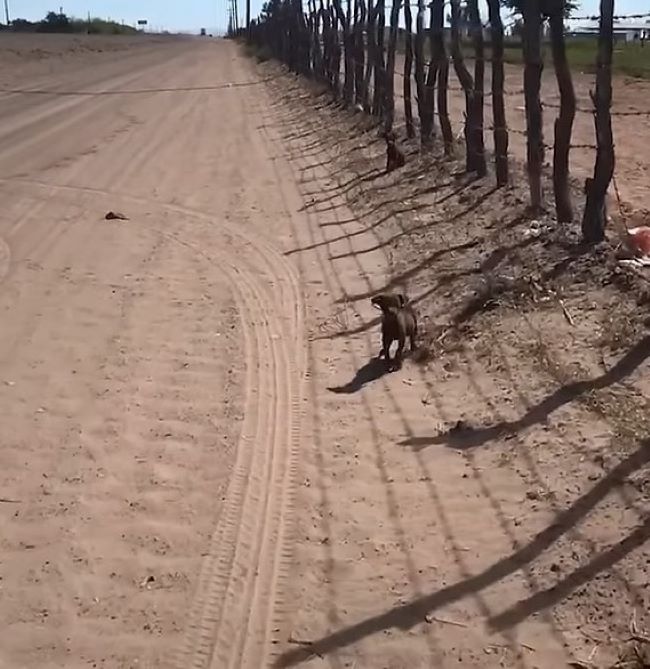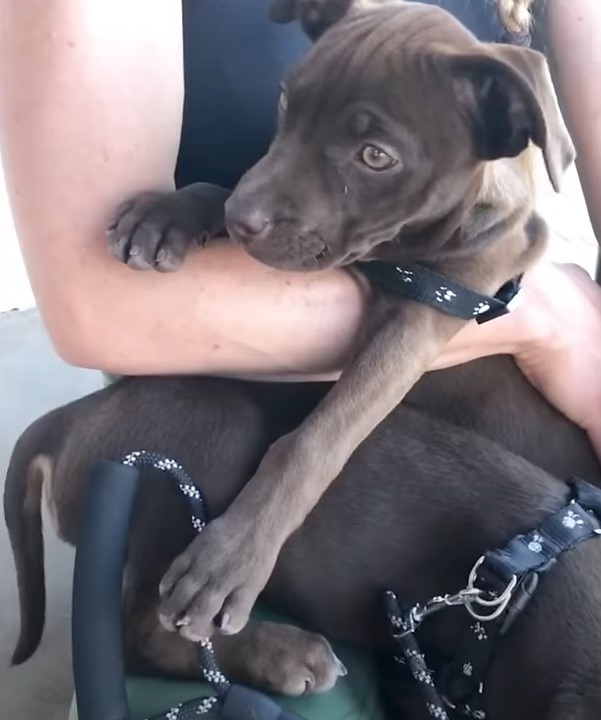Picture this: you are just minding your own business as usual and trying to focus on your work in a pretty big desert when something draws your attention.
It turned out to be two small puppies who couldn’t have been more than two months old. They are coming to you because they are hungry and need help, but what would we all do?
Well, while it may seem like a straightforward answer to some of us, the truth is that a lot of people would simply ignore them and move on with their day, and that is just tragic.
Doing something as simple as giving them a ride to a shelter, or even a phone call to rescue organizations would be more than enough to ensure that they get a new chance.
In this story, we will talk about filmmakers who found these two puppies in a desert and tried to figure out how they could help them.
A New Hope

When the kind people realized that the two puppies were likely hungry, they tried to get close to them in order to help out.
They were surprised to find out that they were very friendly and not scared of humans at all. One of them climbed into a woman’s lap and politely asked for cuddles. He was so adorable.
When thinking about what to do next, one of the filmmakers, Ramy, told The Dodo: “It was obvious that we had to take them in and help them the best way we could.”

Their new rescuers were in a bit of a problem themselves. Because they were nearing the end of a shoot and had to go back home, they had to figure out a way to help them fast.
At first, they realized that they couldn’t take the puppies back home with them, but finding a suitable rescue would be a great option.
They were taken to a veterinarian clinic, where they received a full checkup. Other than needing medications for fleas, they were almost in perfect health.
A Fun Time For The Puppies

One of the rescuers, Estelle, said: “Now that they were all healthy, we wanted them to have the best head start in life.”
They would take them on all sorts of fun adventures in the short time they were there. The puppies would swim in the oasis, run in a big field, and even hike in the mountains.

However, even though they were having the time of their life, their kind caretakers had to figure out a solution to their problems. They needed to find a good shelter.
They tried many different ones, but they received no feedback almost every time. After this, anxiety kicked in as they had to go home soon, but they had no solution yet.
One Final Option

Luckily, the place was amazing, and the staff there immediately accepted the puppies in their care. Both of them breathed a huge sigh of relief.
They are going to be okay. Now that the filmmakers went home, the shelter staff worked tirelessly to find a wonderful family for the puppies.

Estelle said: “They look so beautiful! You can tell that they are very well taken care of.”
In the end, this story shows us how important it is to be kind and caring to dogs because we never know when it can change our own lives or someone else’s.
If you’ve ever noticed your furry friend scratching more than usual, they might be dealing with a pesky issue called mange. This common skin condition can make your pup feel itchy and uncomfortable, but how does it actually happen? Understanding the root cause of mange can help you better care for your canine companion and keep their skin healthy and happy. So, let’s take a closer look at what leads to dogs getting mange and how you can help them find relief. Stay tuned to uncover the secrets behind this irritating skin condition that can affect dogs of all shapes and sizes.
Understanding Mange in Dogs
Mange in dogs is a common skin condition caused by tiny mites burrowing into your pup’s skin. These mites are responsible for the itching, scratching, and discomfort your furry friend may be experiencing.
Types of Mange:
- Sarcoptic Mange: This type is highly contagious and can spread rapidly among dogs. It is caused by the Sarcoptes scabiei mite, leading to intense itching and hair loss.
- Demodectic Mange: Demodex mites naturally live on your dog’s skin. However, when there is an overgrowth due to a weakened immune system, it can result in demodectic mange, characterized by hair loss and skin infections.
Causes of Mange:
- Mites Infestation: The primary cause of mange in dogs is mites. These microscopic parasites can easily transfer from one dog to another through close contact.
- Weak Immune System: A weakened immune system can make your dog more susceptible to mange by allowing mites to overpopulate on the skin.
Symptoms of Mange:
- Intense Itching: Your dog may constantly scratch, bite, or lick their skin due to the discomfort caused by the mites.
- Hair Loss: Mange can lead to patchy hair loss, redness, and skin irritation in affected areas.
- Medicated Baths: Your vet may prescribe medicated baths to help kill the mites and soothe your dog’s skin.
- Topical Medications: Medications such as ointments or spot-on treatments can be applied directly to the affected areas.
Understanding the causes, symptoms, and treatment options for mange in dogs is crucial for providing the necessary care and support to your canine companion. If you suspect your dog has mange, consult your veterinarian for proper diagnosis and treatment.
Types of Mange in Dogs
Sarcoptic Mange:
This type of mange, also known as scabies, is highly contagious and caused by Sarcoptes scabiei mites. The characteristic symptom of Sarcoptic Mange is extreme itching, leading to skin irritation and redness. Dogs usually get infected through direct contact with another infested animal. Sarcoptic Mange is treatable but requires prompt intervention to prevent spreading to other pets or even humans.
Demodectic Mange:
Demodectic Mange results from an overgrowth of Demodex mites that naturally exist on a dog’s skin. When these mites multiply excessively due to a weakened immune system, it leads to Demodectic Mange. Unlike Sarcoptic Mange, Demodectic Mange is not contagious between animals. Symptoms include hair loss, especially around the face and eyes, and skin infections in severe cases. With proper treatment and management of the underlying immune issues, Demodectic Mange can be controlled effectively.
Understanding the two primary types of mange in dogs, Sarcoptic and Demodectic, is crucial for identifying the symptoms early and seeking appropriate veterinary care. Each type requires specific treatments tailored to the mite involved and the extent of the infestation. By knowing the differences between these types of mange, you can provide your furry companion with the necessary care and help alleviate their discomfort.
Causes of Mange in Dogs
Mange in dogs is mainly caused by mites burrowing into their skin, resulting in itching and skin irritation. The primary cause of mange is mite infestation. These tiny parasites can quickly multiply on your dog’s skin, leading to various types of mange.
- Sarcoptic Mange:
Sarcoptic Mange is highly contagious and is caused by Sarcoptes scabiei mites. If your dog comes into contact with an infected animal, these mites can easily transfer. Symptoms include intense itching, redness, and hair loss, particularly on the ears, chest, elbows, and hocks. - Demodectic Mange:
Demodectic Mange occurs due to an overgrowth of Demodex mites, which are normally present on dogs. However, when a dog’s immune system is weakened, these mites can proliferate, leading to Demodectic Mange. This type is not as contagious as Sarcoptic Mange. Symptoms include hair loss, skin infections, and sometimes a greasy coat appearance.
These mites can thrive in different environments, so it’s essential to maintain your dog’s overall health and hygiene to prevent mange infestations. Regular grooming, vet check-ups, and maintaining a healthy diet can help strengthen your dog’s immune system, reducing the risk of mange.
Symptoms of Mange in Dogs
When it comes to the symptoms of mange in dogs, it’s essential to be vigilant and watch out for signs that may indicate your furry friend is affected. Here are the key symptoms you should look out for:
- Intense Itching: One of the most common symptoms of mange in dogs is intense itching. If you notice your dog constantly scratching or biting at their skin, especially in specific areas like the ears, face, and limbs, it could be a sign of mange.
- Hair Loss: Another prevalent symptom of mange is hair loss. Your dog may start losing patches of fur, leading to bald spots on their body. Keep an eye out for any unusual hair loss patterns that could be indicative of mange.
- Skin Redness and Irritation: Mange can cause skin redness and irritation in affected areas. If you observe red, inflamed skin on your dog, accompanied by constant scratching, it could point towards a mange infestation.
- Crusty or Scaly Skin: Dogs with mange may develop crusty or scaly skin, especially around the affected areas. Pay attention to any changes in your dog’s skin texture, as this could be a symptom of mange.
- Secondary Skin Infections: In severe cases of mange, dogs may develop secondary skin infections due to the constant scratching and open wounds. Watch for signs of skin infections like pus, discharge, or foul odor.
- Restlessness and Discomfort: Dogs suffering from mange may exhibit signs of restlessness and discomfort, as the itching and irritation become unbearable for them. Keep an eye on your dog’s behavior for any unusual signs of distress.
By recognizing these symptoms early on, you can promptly seek veterinary care and start appropriate treatment to help your dog recover from mange and alleviate their discomfort.
Diagnosis and Treatment of Mange in Dogs
When it comes to diagnosing mange in dogs, your veterinarian will typically perform a skin scraping to check for mites or their eggs under a microscope. This helps confirm the type of mange your dog has – Sarcoptic or Demodectic. If necessary, your vet may also conduct additional tests to identify any underlying health issues that could be contributing to the condition.
###Symptoms-based Diagnosis
- Skin Scraping: This simple procedure involves collecting a small sample of your dog’s skin for examination under a microscope to detect mites.
- Confirming the Type: Different types of mange require specific treatments, so identifying the exact type is crucial for effective management.
- Additional Tests: In some cases, your veterinarian may recommend blood tests or skin biopsies to rule out other potential causes of skin issues.
###Treatment Protocols
After confirming the diagnosis, your vet will prescribe appropriate treatment based on the type of mange your dog has. Treatment typically involves medications such as medicated baths, oral medications, or spot-on treatments to eliminate the mites and manage symptoms.
- Medications: Depending on the severity of the mange, your vet may prescribe antiparasitic drugs, antibiotics for secondary infections, or anti-inflammatory medications to alleviate itching and inflammation.
- Topical Treatments: Medicated shampoos or spot-on treatments can help kill mites and soothe your dog’s skin, promoting healing and hair regrowth.
- Follow-up Care: Treatment for mange may require multiple vet visits for progress monitoring and adjustments to the treatment plan as needed.
Remember, early detection and prompt treatment are essential for managing mange effectively in dogs. Always follow your veterinarian’s recommendations closely to ensure the best possible outcome for your furry friend.
Prevention and Management of Mange in Dogs
Regular Veterinary Check-Ups
Schedule routine vet visits to monitor your dog’s skin health. Early detection of mange symptoms can lead to prompt treatment and faster recovery.
Clean Living Environment
Maintain a clean living space for your dog by regularly washing their bedding and toys. Clean surroundings help prevent mites from multiplying and affecting your pet.
Avoid Contact with Infected Animals
Keep your dog away from animals with mange to prevent the spread of mites. This can reduce the risk of your pet contracting mange from other infected animals.
Preventative Medications
Discuss with your vet about preventative medications to protect your dog from mange. These medications can help boost your pet’s immune system and prevent mite infestations.
Proper Nutrition
Provide a balanced diet to strengthen your dog’s immune system. A healthy immune system can aid in preventing mange infestations and promote overall well-being.
Regular Grooming
Regular grooming sessions can help you spot any skin issues early on. Thoroughly check your dog’s skin and coat for signs of mange or other skin conditions.
Immediate Treatment
If you suspect mange, seek veterinary care promptly. Early diagnosis and treatment are key to managing mange effectively and preventing complications.
Follow Vet Recommendations
Follow your vet’s advice on medications, treatments, and follow-up care. Adhering to their instructions can ensure successful mange management and your dog’s speedy recovery.
Conclusion
That’s a wrap on how dogs can get mange. Remember, early detection is key to tackling this pesky issue. Keep an eye out for any suspicious symptoms and act promptly. By taking preventive measures like regular vet visits, maintaining a clean environment, and staying on top of grooming, you can help your furry friend stay mange-free. Stay informed, stay proactive, and your pup will thank you for it!
Frequently Asked Questions
What is Sarcoptic Mange?
Sarcoptic Mange is a skin condition in dogs caused by Sarcoptes scabiei mites. These mites burrow into the dog’s skin, leading to intense itching, hair loss, and skin irritation.
What is Demodectic Mange?
Demodectic Mange is caused by Demodex mites, which are normally present in small numbers on a dog’s skin. However, overgrowth can occur due to a weakened immune system, resulting in hair loss, redness, and skin infections.
How can I prevent mange in my dog?
Prevent mange by maintaining a clean living environment, avoiding contact with infected animals, ensuring proper nutrition, regular grooming, and considering preventative medications recommended by your vet.
What should I do if I suspect my dog has mange?
If you suspect mange in your dog, seek immediate veterinary care for proper diagnosis and treatment. Early detection and treatment are crucial for your dog’s recovery.
[no_toc]

Hey there, I’m Janet Brooks, a dog-loving student from California. I’m all about helping pups in need, especially those without homes. Me and my awesome friends work together to give shelter and love to stray dogs. Oh, and I also write blogs about dogs to share helpful info.